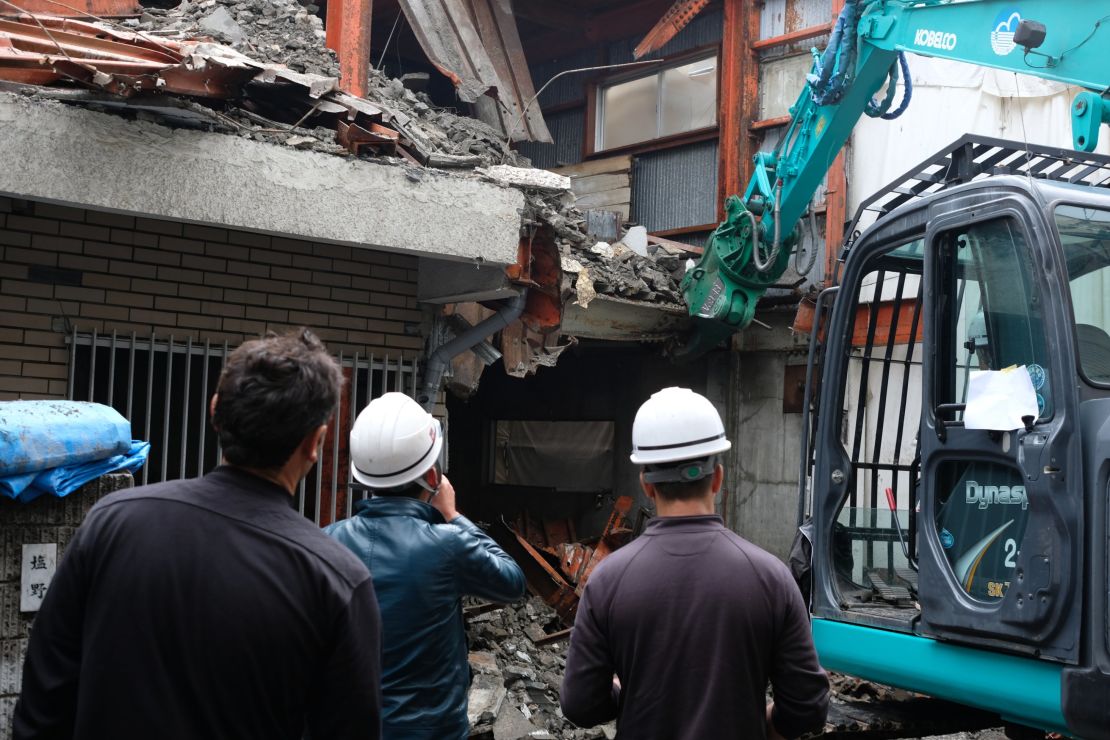Demolition worker Yuichi Aoki’s face creases up when he thinks about Japan’s future.
“I got asked to resign from my job in the IT industry when I was 55,” Aoki, 59, tells CNN as he takes a break from tearing down a derelict house in Saitama, Japan.
“Now I have to work into my sixties. I worry about how my children and their children will cope with an increasingly ageing population.”
Considerably older than most of his co-workers, Aoki, a former IT worker is also one of only a handful of Japanese nationals employed by a Saitama-based demolition company owned by a Kurdish former asylum seeker.

The company, the majority of whose workers hail from Turkey, Iran and various parts of Africa, is somewhat unique in Japan, where foreign nationals make up just 1.6% of the country’s overall population.
Operated by Mehmet Yucel, 28, the company is part of a growing and largely unregulated grassroots economy, that is helping to ease Japan’s labor shortage in so-called undesirable sectors such as demolition and construction.
Since founding the company in 2016, Yucel says he has received daily calls from immigrants in search of work – some with the right to work legally and others without.
“Japan is turning a blind eye to these workers because it needs them, but it won’t come up with a proper long-term strategy for them,” says Yucel, whose company is located on the fringes of the Japanese capital.
Yucel came to Japan 12 years ago to escape ethnic conflict. Now married to a Japanese woman, he has permanent residency status.

Part of a increasing group of 2.23 million legal immigrants, Yucel considers himself one of the lucky ones. Though Japan is the fourth-largest donor to the UN Refugee Agency (UNHCR), in 2016, it accepted just 28 refugees from a total of 10,901 applicants.
Graying population
Japan is considered a “super-aged” nation, where more than 20% of the population is over 65 and the birth rate has reached record lows.
By 2060, the country’s population is expected to plummet by more than 40 million from 2010, to 86.74 million people, according to a projection by the Japanese Health Ministry. With fewer workers paying taxes to support a growing silver population in need of pensions and healthcare services, Japan’s economy is facing an unprecedented challenge.
This year, labor shortages were the highest they’d been in 40 years, and analysts predict rising shortages in the years ahead.
Calling Japan’s shrinking population an “incentive” as opposed to a “burden,” Prime Minister Shinzo Abe has attempted to encourage more senior citizens and women to join the workforce. Yet outside observers argue that large-scale immigration would provide a more obvious fix to Japan’s labor crisis and demographic issues.
But there appears little appetite among the country’s political class to increase levels of immigration, however important the need.
In 2005, the then-director of the Tokyo Immigration Bureau Hidenori Sakanaka, promoted a plan where Japan would accept 10 million immigrants over a 50-year period. Few people supported the idea and it was later dropped.
“Japan doesn’t have an immigration policy – this is something that politicians stress,” Chris Burgess, a migration researcher and lecturer of Japan studies at Tsuda Juku University in Tokyo, tells CNN.
“Many people in Japan believe that the country’s peace and harmony is based on it being a homogenous country where there are few foreigners,” says Burgess. “That kind of thinking pervades a lot of aspects of society and underlies the no immigration principle.”
Door is closed
Japan’s attitude to the outside world is nothing new, and the country has a history of being closed off from foreign influence.
During a period of isolation between 1641 to 1853, Japan barred its nationals from leaving and foreigners from entering. Only traders from China and the Netherlands were allowed at the port of Nagasaki on Japan’s southernmost island of Kyushu.

Nor did Japan rely on foreign labor during its era of rapid economic growth between 1955 and 1973.
Only in the late 1980s, with the threat of a growing labor shortage, did the country debate the possibility of accepting foreign workers, according to Atsushi Kondo, a law professor and immigration expert at Meiji University.
Since 1988, the Ministry of Labor has welcomed a small number of foreigners with high skills and qualifications. In the 1990s, the country began to encourage the return of nikkeijin (people of Japanese descent) to the country, under a special visa program.
But the doors remain closed to low-skilled workers.
Though Abe has mentioned the need for “foreign technicians” to construct buildings for the Tokyo 2020 Olympics, he stressed that this should not be misunderstood as an implementation of an immigration policy at an economic meeting held with his cabinet in April 2014.
The “technical trainee” program is a heavily criticized government program where foreign workers – predominantly from China and Southeast Asia – travel to Japan to work in the agriculture and manufacturing industries purportedly to acquire skills to bring back to their respective countries. Experts argue, however, that this program has led to the exploitation of some, and forced others to depend on loopholes in the system.
‘Smoke and mirrors’
In a small office in northeast Tokyo, Ippei Torii, who has fought for migrant rights for the better part of two decades, is exasperated. He maintains that Japan’s labor shortages could be solved if there was an actual visa for manual laborers seeking to come Japan.
Torii, the director of nonprofit organization, Solidarity Network with Migrants Japan (SNMJ) tells CNN that instead of creating a long-term immigration strategy that would allow low-skilled workers to have access to the same rights as Japanese citizens, the government has continuously opted for “back door” measures that allow low-skilled foreign workers into Japan on a temporary basis.
Torii slammed the technical trainee program, asserting that foreign workers ended up taking menial jobs as opposed to learning skills they could take back to their respective countries. He criticized another measure that allows foreign students in Japan to work up to 28 hours part time.
“These programs are all just smoke and mirrors,” says Torii.
A spokesman from Japan’s Ministry of Justice, however, refuted Torii’s claim.
“It’s not true that we use backdoor policies and tolerate illegal immigration to help solve the labor shortage,” he tells CNN.
“The asylum seeker’s application status is misused by illegal immigrants and we believe that most of the applicants aren’t really asylum seekers. That delays the process for real asylum seekers,” he says.
In 2016, Japan saw a 44% increase in asylum applicants with Indonesia, Nepal and the Philippines being the top three countries of origin.
A 2010 legal revision has led to the rise of economic migrants posing as asylum seekers, according to Takizawa Saburo, an expert on refugee policy and a member of the Ministry of Justice Immigration Policy Discussion Panel.
“As Japan doesn’t accept unskilled laborers, many people from countries in Southeast Asia have no way of coming to Japan to work, except through the asylum route,” Saburo tells CNN.
The 2010 legal revision allows foreigners with valid visa statuses who apply for asylum to start working six months after their application is submitted. While it allows asylum seekers waiting for their cases’ outcome to regain a sense of normalcy and support themselves, it doesn’t allow those without a valid visas status who apply for asylum to work.
“When this loophole in the law was discovered, it spread through word of mouth and is well-known nowadays,” says Saburo.
Caught in the system
In May of this year, around 20 asylum seekers detained at the Tokyo Regional Immigration Bureau staged a rare two-week hunger strike.
Frustrated by a bureaucratic system that is often slow to process cases, the protesters demanded an end to repeated detentions and a more viable path to working visas.
Yuki Moriya, a UNHCR Japan spokeswoman, tells CNN the current issue was “really a chicken-and-egg problem.”
“While the numbers of asylum seekers have increased, the numbers of immigration officials hasn’t, and that’s led to a real delay in processing all these cases. It’s hard for both parties,” she says.

At Yucel’s demolition site, 25-year-old Kurdish asylum seeker Nurettin, knows what it’s like to be caught in the system.
He arrived in Japan in 2012, fleeing conflict in southeast Turkey, and has spent two stints in an immigration detention center. He is waiting for his asylum case to be processed.
Nurettin has no legal right to work, but he can depend on the grassroots support of men like Yucel, and on a larger Saitama-Tokyo based community of around 1,400 Kurdish migrants to get by. He’s had no difficulty working alongside his Japanese colleagues despite the language barriers.
“We might have different beliefs and ideologies, but when we’re at work it doesn’t matter, we just get the job done,” Nurettin says.
“I’d be happy to pay taxes to the state if I could receive more support in return, but I don’t see that happening anytime soon.”
To his side, Aoki nods in agreement.
“Young people in Japan don’t want to do demolition work, so it’s helpful to (Japanese) society that foreign workers want to do this, and they should get support from the state in return,” Aoki says.
“Japan really needs to get over its identity as a homogenous nation. If the country remains closed off, the future is uncertain.”
CNN’s Yoko Wakatsuki contributed to this report







